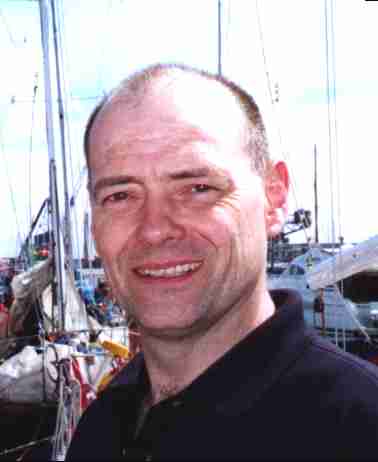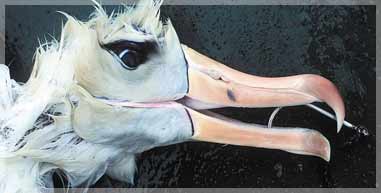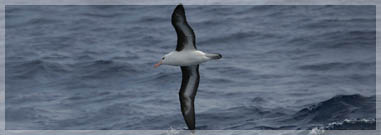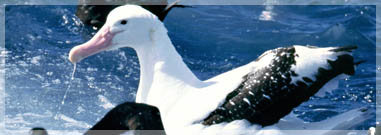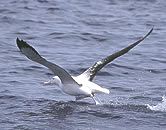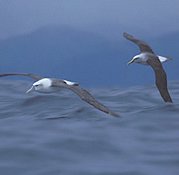|
VOLVO OCEAN RACERS - ADOPT SAVE ALBATROSS CAMPAIGN |
|||||||||||||||||||||||||||||||||||||||||||||||||||||||||||||||||||||||||||||||||||||||||||||||||||||||||||||||||||
|
HOME BIOLOGY CREW GEOGRAPHY HISTORY INDEX MUSIC THE BOAT SOLAR CELLS SPONSORS |
|||||||||||||||||||||||||||||||||||||||||||||||||||||||||||||||||||||||||||||||||||||||||||||||||||||||||||||||||||
|
The Volvo Ocean Race Launch - 7 October 2005
Graham Wynne, the RSPB's chief executive, Ramon Marti of SEO (the BirdLife partner in Spain) and Marco Lambertini of BirdLife International, joined a host of invited VIPs to watch the launch of the 2005-2006 Volvo Ocean Race, in Vigo, Spain this weekend.
Amid a roar of cannons, seven ocean racing yachts set sail on a 31,000-nautical-mile journey, which will take the vessels through some of the richest albatross waters in the world.
Graham Wynne said: 'It is a humbling moment to watch seven crews set sail bravely into the vastness of the Atlantic Ocean. During their journey, crew members will have prolonged contact with albatrosses - birds that will be almost constant companions during the Southern Ocean legs of the race.
Nelson Kruschandl - Save the Albatross
'Fortunately, the crews won't witness the deaths of an estimated 60,000 albatrosses before the race finishes in Gothenburg, next June. 'Fortunately, the crews won't witness the deaths of an estimated 60,000 albatrosses before the race finishes in Gothenburg, next June.' 'The challenge to prevent this slaughter seems as great as that posed by ocean racing, but the spirits of the competitors proves that you can take on mighty challenges and win.'
The
RSPB and BirdLife International have launched a Save the Albatross
campaign to ensure the survival of the 19 out of 21 species of
albatross which are threatened with global extinction because of
longline fishing. The aim of
the campaign is to raise awareness and funds for Operation Ocean Task
Force. This practical project aims to drastically reduce the number of
seabirds killed on longline hooks. People will be working at sea to
train fishermen to adopt simple measures, such as attaching streamers
to the longlines to scare seabirds away and prevent the birds becoming
accidentally hooked and drowned. Volvo Ocean Race officially adopted the Save the Albatross campaign in October, which has already attracted the support of a range of high-profile individuals, including HRH Prince Charles, Sir David Attenborough, Ellen MacArthur, Rick Stein, Richard Briers and Simon Cowell. The Save the Albatross campaign is organised by BirdLife International and the RSPB, and is supported by the Volvo Ocean Race 2006. Visit www.savethealbatross.net for more information.
BirdLife International (www.birdlife.org) BirdLife International is a global partnership of organisations working in over 100 countries worldwide, to improve the quality of life for birds, for other wildlife, and for people. Download 'Sea Change' - BirdLife's Global Seabird Programme newsletter
The
RSPB (www.rspb.org.uk)
is the UK partner organisation of BirdLife International, and is the
UK charity working to secure a healthy environment for birds and
wildlife.
Death on a hook
Too many needless and horrid deaths
100,000 albatrosses die each year on fishing hooks. They are being killed in such vast numbers that they can't breed fast enough to keep up. This is putting them in real danger of extinction.
Death on a hookPicture the scene. One minute you're an albatross gliding across the ocean majestically. You spot a fishing boat, surrounded by other birds, and you know from experience that it offers an easy meal (might be discarded fish waste or bait). You swoop in to pick up a particularly tasty piece of squid.
As you swallow the bait down, there is a sudden, terrible pain.The hook embedded in the bait catches and rips your throat. Helplessly, you find yourself dragged down into dark, cold waters. You choke and drown and are dragged deep down below the surface. You're unnoticed until your bedraggled corpse is hauled up and discarded.
This happens to an albatross around once every five minutes.One more to add to the 100,000 of your kind killed this way every year.Back on land, your partner and your chick are waiting for you to return with food - but you aren't coming back. So your chick will inevitably die of starvation, exposure or stress.
A billion hooks out a yearLongline fishing fleets, which operate throughout the world's oceans, target vast numbers of tuna, swordfish, Patagonian toothfish and other species. The boats set fishing lines that can stretch for 130 kilometres (or 80 miles) into the ocean. Each line carries thousands and thousands of hooks baited with squid and fish. These attract albatrosses, which get caught, dragged below the water and drown. The large fish these boats catch are in high demand. Single bluefin tuna have fetched as much as US$100,000 on the Japanese market.
Why are albatrosses so vulnerable?Albatrosses are exceptionally susceptible to longlining. They can't breed fast enough to cope with the rate at which they are being killed. Other species, with different life cycles, might be able to survive. Why is this so?
Fishing crews can use simple measures to stop albatrosses from getting hooked. Like many other seabirds, albatrosses face threats at sea and on land, such as introduced predators and habitat destruction. However, the biggest threat faced by most species is death on longline fishing hooks. Many of these tragic and needless deaths could be stopped. We have the solutions - you can help us put them into practice. 19 of the 21 species of albatross in the world are threatened with extinction largely because of longline fishing. BirdLife International compiles the official list of threatened birds. Currently, 2 albatross species are Critically Endangered, 7 are Endangered and 10 are Vulnerable. Pirate fishingAround a third of albatross deaths are caused by illegal, unreported and unregulated fishing fleets. At its worst, pirate fishing is organised crime, in which vessels plunder fish stocks with no regard for regulations, national sovereignty or bird protection. They leave devastation in their wake.
Volvo Ocean Race heads towards albatross hotspots6 January 2006
The seven yachts in the round-the-world Volvo Ocean Race have now set sail for Australia, on a journey that will take them through some of the world’s greatest albatross hotspots.
The Prince Edward Islands are home to the first major albatross colonies that the race will come near to after leaving Cape Town. These islands, which belong to South Africa, are uninhabited, apart from scientific researchers. Marion Island, the larger, and Prince Edward Island are about 1,200 miles south-east of Cape Town.
The islands are home to thousands of pairs of breeding albatrosses. Most of them will have young on the nest and will be actively scouring the ocean for food, some travelling thousands of miles from their nests in a single journey.
Two of the species that breed here are classified as endangered. The sooty albatross breeds on both islands, and the 2,750 pairs represent half the Indian Ocean population and 21 per cent of the world population. The Indian yellow-nosed albatross breeds on the smaller Prince Edward Island and the 6,000 pairs are 17 per cent of both Indian Ocean and world populations.
The population of wandering albatrosses on the islands (2,700 pairs) represent nearly half of the Indian Ocean breeding population, and the commonest species is the grey-headed, with 7,700 pairs breeding.
Tracking albatrosses, using radio-transmitters, has shown that the western part of the southern Indian Ocean is most used by feeding birds, with very few in the east. Breeding birds from islands further east and non-breeding birds from other colonies also feed in the same waters as the Prince Edward Islands’ birds. Grey-headed albatrosses from South Georgia will roam that far, as will shy albatrosses from Tasmania.
Good feeding areas for seabirds are likely to be good areas for fisheries, and the Volvo Ocean Race crews may well see fishing vessels in this area. Japanese, Korean and Taiwanese fishing fleets all undertake longline fishing for tuna in this region and there is a Patagonian toothfish fishery off Prince Edward Island. Indian yellow-nosed albatrosses are known to be caught by longline fisheries off both South Africa and Australia.
SECOND LEG: QUOTES FROM THE BOATS - 11 January 2006
The yachts left Cape Town, South Africa, on 2 January on the second leg of the Race, bound for Melbourne, Australia. The course takes them past the Prince Edward Islands, Crozet, Kerguelen and Amsterdam Islands, all with important albatross colonies.
The waters in this region are rich in fish and other marine life and so the albatrosses spend a great deal of time out at sea, feeding. This is where they will come into contact with longline fisheries, and it is also where the crews aboard the Volvo Ocean Race yachts will get close to them.
Some quotes from the crews show how they are all both entertained, enthralled and enthused by these magnificent birds:
Bouwe Bekking, movistar, 6 January
Paul Cayard, Pirates of the Caribbean, 6 January
Simon Fisher ABN AMRO TWO 7 January
Bouwe Bekking, movistar, 7 January
Paul Cayard, Pirates of the Caribbean, 7 January
Europe’s secret albatrosses - 13 January 2006
It is a little-known fact that the European Union is home to more breeding albatrosses than any other country in the world. More than a third of the world’s albatrosses breed on islands which form part of the overseas territories belonging to France and the UK.
Three albatross species breed only in EU overseas territories and nowhere else, with a further five species having about two-thirds or more of their world population found on these islands.
All are under threat at sea, from longline fishing that kills thousands every year, and on land from introduced predators, like cats, rats and mice.
The French Southern (Austral) and Antarctic Territories (TAAF) include several islands and the Adélie coast of Antarctica. The islands consist of the Kerguelen Islands, Crozet Islands, Amsterdam Island and St Paul Island. All are uninhabited, apart from some visiting scientists, and their wildlife, which includes 60,000 pairs of breeding albatrosses of eight species.
Alison Duncan, international officer for LPO, BirdLife International's partner in France, said: ‘France has a huge responsibility for albatrosses, with eight of the world's 21 species nesting in the French Southern Territories surrounded by a vast fishing zone. ‘One, the Amsterdam albatross - which only nests on the French island - is critically endangered and has an annual nesting population of only 17 pairs, making it the world's rarest albatross and arguably the one closest to oblivion.’
The UK’s Overseas Territories in the South Atlantic are home to all of the albatrosses which breed in that region. These are found on Tristan da Cunha, Gough Island, the Falkland Islands, and South Georgia and seven species breed on these islands, numbering 592,000 pairs.
Two species breed only in the UK’s Overseas Territories, with the whole of the world’s breeding population found there: the Atlantic yellow-nosed albatross, is found on Tristan da Cunha and Gough Island; and the Tristan albatross, found mainly on Gough Island with a few on Tristan da Cunha.
Alistair Gammell, the RSPB's International Director, said: ‘The UK Overseas Territories support more than one third of all the world's nesting albatrosses and more than a half of all those in the Southern Ocean. Although these South Atlantic islands are very remote, they are still the UK's responsibility, making the albatrosses which nest on them as British as if they were nesting on the top of the White Cliffs of Dover.’ Five species have about two-thirds or more of their world population breeding on these islands. These are black-browed albatross (78%), grey-headed albatross (71%), Indian yellow-nosed albatross (82%), sooty albatross (79%) and wandering albatross (65%).
All of these birds are vulnerable to longline fishing that is widespread throughout the Southern Ocean where these birds feed. It claims 100,000 albatross lives worldwide each year, with many fishing fleets operating in the area south of the Indian Ocean. Many of the islands have problems with introduced predators which attack the eggs and young of nesting albatrosses. It was recently discovered that abnormally large house mice are killing albatross chicks on Gough Island.
The Volvo Ocean Race, which is supporting the Save the Albatross campaign, is sailing past the French islands during the second leg of the race and will be heading towards the South Atlantic in February, close to some of the UK’s albatross isles.
LINKS:
Save the Albatross campaign news
The RSPB and conservationThe RSPB and your workThe RSPB and youthCloser to youGuides
|
|||||||||||||||||||||||||||||||||||||||||||||||||||||||||||||||||||||||||||||||||||||||||||||||||||||||||||||||||||
|
|||||||||||||||||||||||||||||||||||||||||||||||||||||||||||||||||||||||||||||||||||||||||||||||||||||||||||||||||||
